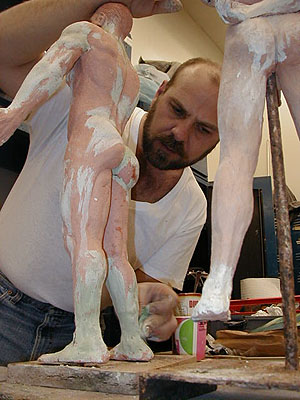© CJ Mingolelli,
2001-2010
Site Designed by
 | |
| | Firing the Sculpture |
|
|
 |

Sculptures (Donnie and Gianni) after firing - numerous breaks have been repaired with 2-part epoxy glues and putty, and once the breaks cure, water based putties are used to fill in any remaining crevasses and cracks.
|
The final state of a sculpture depends on how well it's fired.
It's a crucial time for a fine work of art - things can go wrong, and the sculptor must be prepared for the worst, but remain optimistic that the work will remain true to it's original form. The kiln is one of the most important tools when working with raw clay sculpture. The kiln itself must be well maintained, and checked regularly for wear and tear. A kiln in disrepair can cause disaster not only to the artwork it contains, but in to the locale in general.
The firing process converts raw clay into stoneware. How long and how hot the firing are very important - minimal heat and or time may bring clay to a semi-solid state (such as bisque) and will need to be fired again. Excessive heat and or time can cause the clay to become malleable, and bend or warp the sculpture's shape.
The firing process is actually quite simple, but does take patience to ensure all steps are properly completed. Firing is a very slow and painstaking process - which if done properly should take several days to complete.
The firing process will always alter the sculpture simply because the form is being hardened through the heating process. This process causes the work to expand and contract throughout the duration of the firing process. Ultimately, the sculpture will appear the same once it's complete, but in reality it is smaller because it has been altered - all moisture has been removed and the sculpture has been turned into a hardened solid material.
The firing process has completed, you have examined your work, the work fired well and remained intact and complete (or not...).
Sometimes, this is not the case - many works of art do not emerge from the kiln intact. What generally happens is the sculpture cracks at a stress point, and will need to be repaired and retouched before you can finish the work.
Once, the worst thing that could happen - happened, and I lost a sculpture to an exploding kiln - because that kiln was not well maintained. Most times, I was fortunate, my sculptures were generally in good shape, and with some minor touch-ups they were complete. Now, it's time to go on to finishing the work.
In basic terms the process is as follows:
- Once the sculpture has been properly dried it is ready to be loaded in the kiln.
- The kiln must then be warmed slowly with the sculpture - this allows any excess moisture to slowly evaporate before the intense heat begins.
- The time and temperature are set at intervals during the process. Some kilns differ, but most use a cone - a piece of clay that will keep the kiln running until it bends and disengages the switch. Cones come in different sizes, the larger the longer a time frame the kiln will run.
- Once the thermostat setting is reached for the main firing - it begins, it remains at a constant temperature for at least 24 hours. A kiln set with a temperature too high for the clay material can cause an explosion, so be sure to set it properly for the clay type you're using.
- Once the firing time is completed, the kiln slowly cools, which should take at least another 24 hours. After that, the sculpture should be warm but is ready to unload.
|
| |
